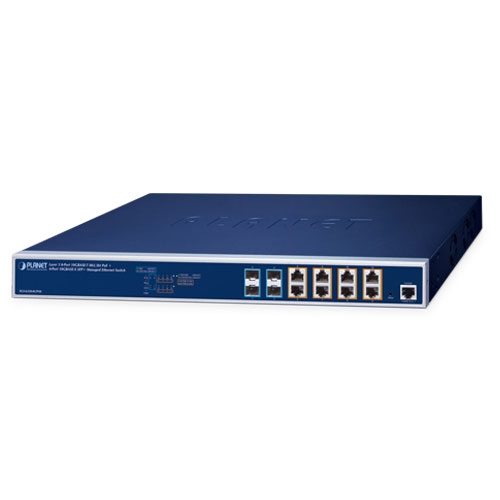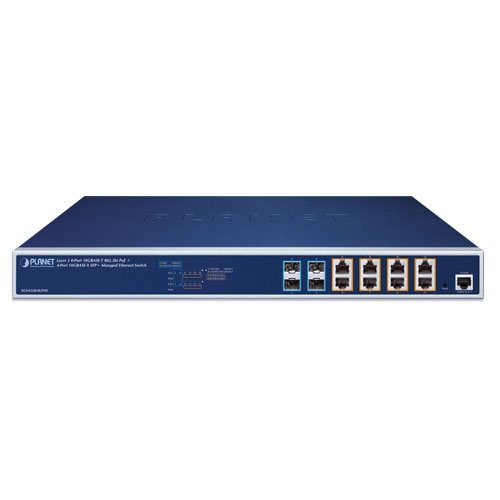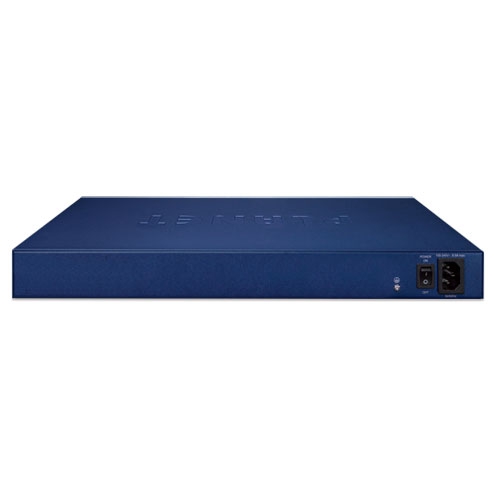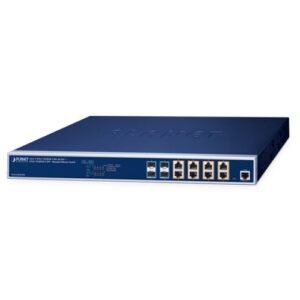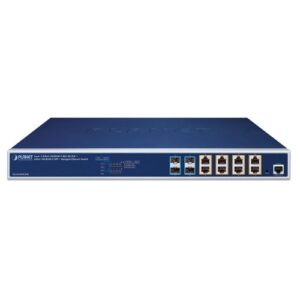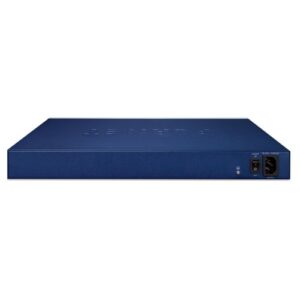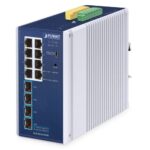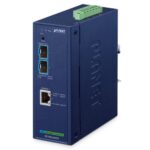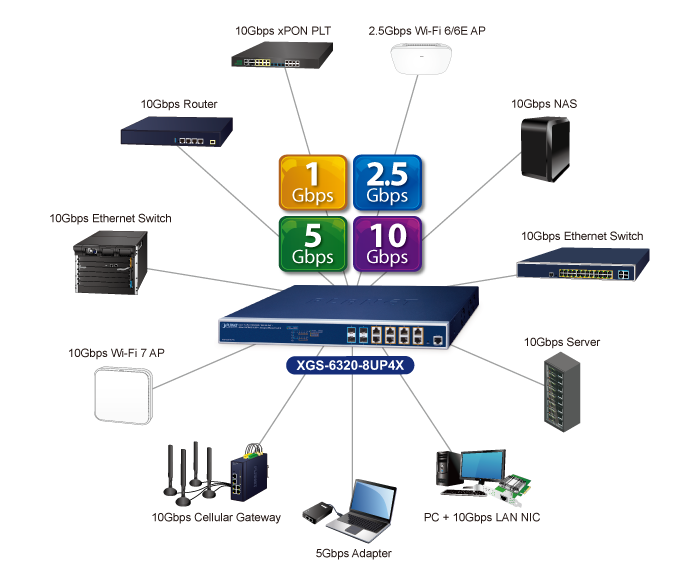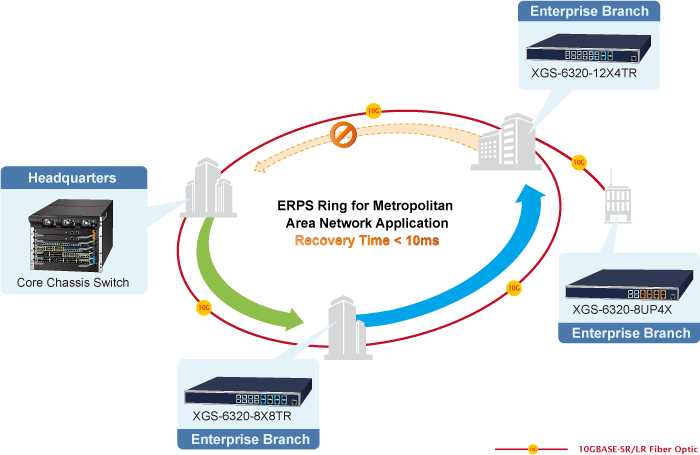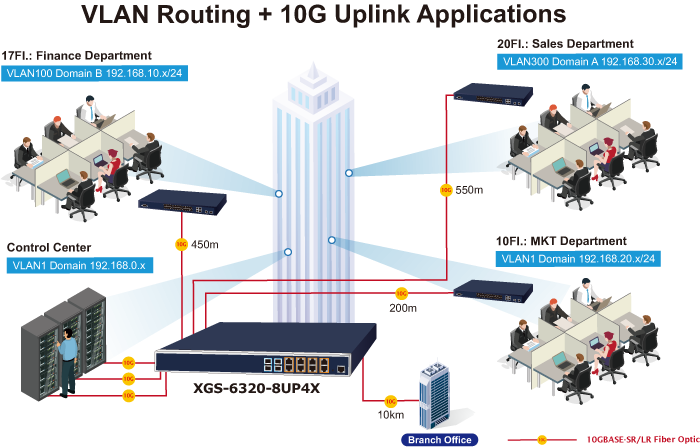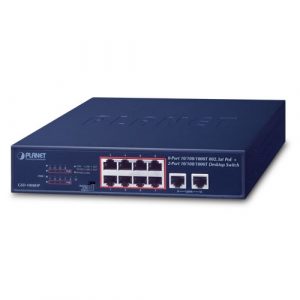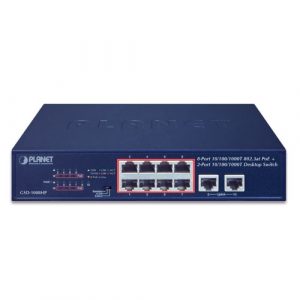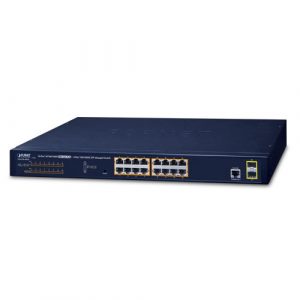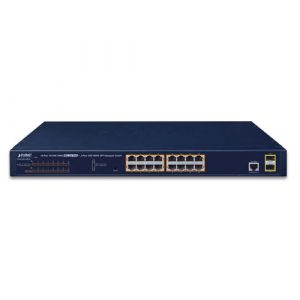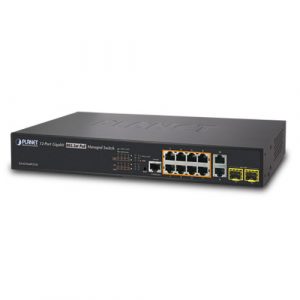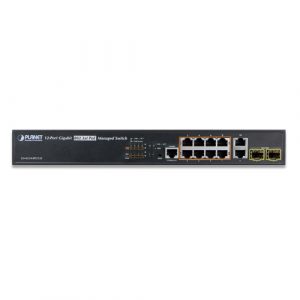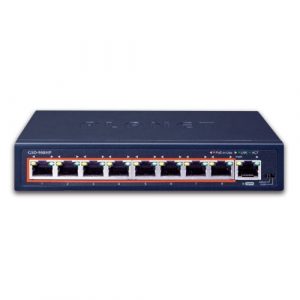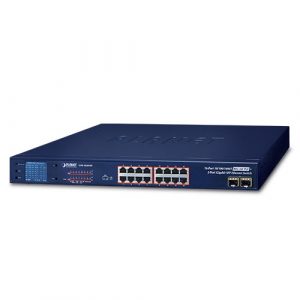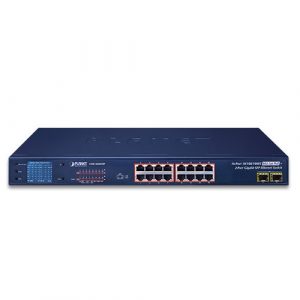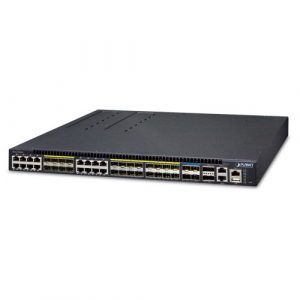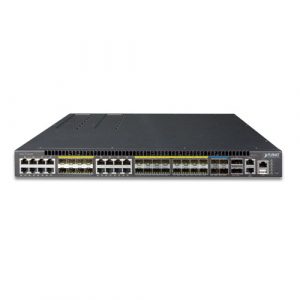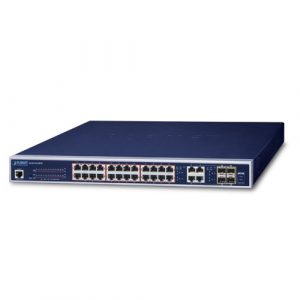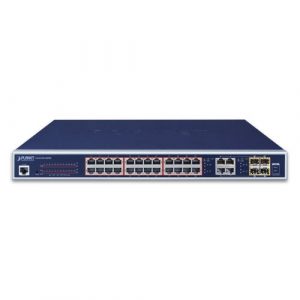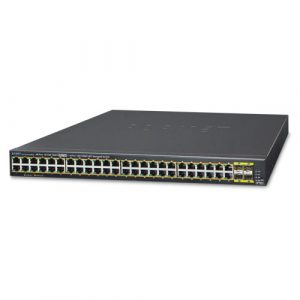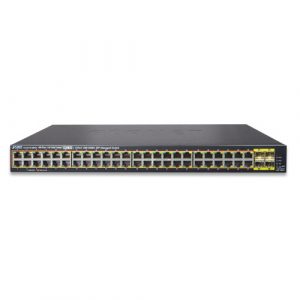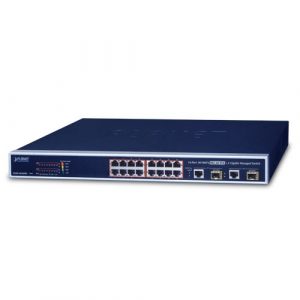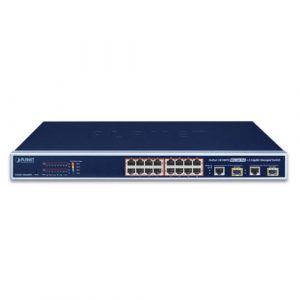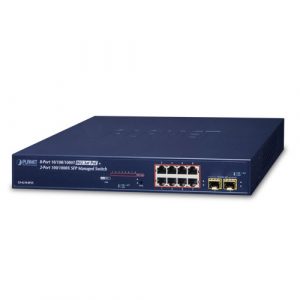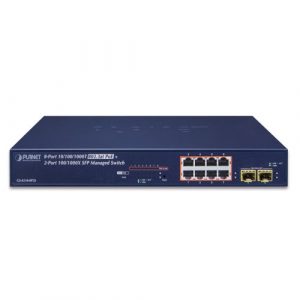XGS-6320-8UP4X
Layer 3 8-Port 10GBASE-T 95W 802.3bt PoE + 4-Port 10GBASE-X SFP+ Managed Ethernet Switch
- Applicazioni
- SPECIFICHE
- DOWNLOAD
Descrizione
Switch gestito L3 10G All-Port con un’eccezionale capacità PoE++ da 95 W
Lo switch PoE++ Ethernet Layer 3 10Gbps PLANET XGS-6320-8UP4X è progettato per dispositivi a larghezza di banda elevata e ad alto consumo energetico come AP Wi-Fi 7/6E, unità NAS, thin client e sistemi di sorveglianza. Dotato di 8 porte in rame 10GBASE-T e 4 porte in fibra 10GBASE-X SFP+, garantisce una connettività flessibile con portata estesa.
Con un robusto budget PoE da 420 W, ciascuna porta in rame fornisce un’alimentazione PoE massima di 95 W, soddisfacendo le esigenze dei dispositivi PD IEEE 802.3bt PoE++ Tipo 4. Oltre alla potenza, lo switch eccelle in termini di funzionalità di collegamento dati, routing Layer 3 basato su hardware e un motore di commutazione Layer 2 e Layer 4 all’avanguardia. Le interfacce di gestione IPv6/IPv4 intuitive garantiscono un controllo continuo.
Progettato per aree metropolitane, città intelligenti e imprese, XGS-6320-8UP4X potenzia le reti di nuova generazione a larghezza di banda elevata. Le prestazioni della rete possono essere elevate con lo switch Ethernet PoE lungimirante di PLANET.
Interfacce Dual Media 10GBASE-T e 10GBASE-X SFP per applicazioni con larghezza di banda diversificata
XGS-6320-8UP4X di PLANET ha la capacità di raggiungere un’alta velocità di 10 Gbps su cavi in rame o fibra ottica che aiuta ad accelerare le prestazioni della trasmissione di dati di grandi dimensioni. Le interfacce in rame 10GBASE-T integrate supportano la negoziazione automatica a 5 velocità (10G/5G/2,5G/1G/100) e la trasmissione dati a 10 Gbps con il cablaggio UTP Cat6/Cat6A esistente, il che significa che la velocità può essere aumentata senza costi . Può sicuramente darti la velocità che richiedi e il suo Plug and Play semplifica l’installazione.
Le interfacce in fibra ottica 10GBASE-X SFP+ supportano 3 velocità, 10GBASE-SR/LR, 2500BASE-X e 1000BASE-SX/LX, il che significa che ora l’amministratore può scegliere in modo flessibile il ricetrasmettitore SFP/SFP+ adatto in base alla distanza di trasmissione o alla trasmissione velocità necessaria per estendere la rete in modo efficiente.
Anello ridondante, ripristino rapido per applicazioni di rete critiche
La serie XGS-6320 supporta la tecnologia ad anello ridondante e presenta una capacità di ripristino automatico forte e rapida per prevenire interruzioni e intrusioni esterne. Incorpora la tecnologia avanzata ITU-T G.8032 ERPS (Ethernet Ring Protection Switching) e il protocollo Spanning Tree (802.1w RSTP) nella rete del cliente per migliorare l’affidabilità del sistema e il tempo di attività in ambienti difficili. In una determinata rete ad anello semplice, il tempo di ripristino potrebbe essere inferiore a 10 ms per riportare rapidamente la rete al normale funzionamento.
Supporto del routing di livello 3
La serie XGS-6320 consente all’amministratore di aumentare comodamente l’efficienza della rete configurando manualmente il routing statico VLAN IPv4/IPv6 Layer 3 e automaticamente le impostazioni RIP (Routing Information Protocol) o OSPF (Open Shortest Path First).
Il RIP può utilizzare il conteggio dei hop come metrica di routing e prevenire i loop di routing implementando un limite al numero di hop consentiti in un percorso dall’origine alla destinazione.
L’OSPF è un protocollo di routing dinamico interno per sistemi autonomi basato sullo stato del collegamento. Il protocollo crea un database per lo stato dei collegamenti scambiando stati dei collegamenti tra gli switch di livello 3, quindi utilizza l’algoritmo Shortest Path First per generare una tabella di routing basata su quel database.
Applicazione di routing VLAN di livello 3
Con i robusti protocolli di routing del traffico IPv4/IPv6 Layer 3 integrati, la serie XGS-6320 garantisce un routing affidabile tra VLAN e segmenti di rete. I protocolli di routing possono essere applicati dall’interfaccia VLAN con un massimo di 3K voci di routing. La serie XGS-6320 è sicuramente una soluzione conveniente e ideale per le aziende.
Robuste funzionalità di livello 2
La serie XGS-6320 può essere programmata per funzioni avanzate di gestione dello switch, come aggregazione dinamica dei collegamenti delle porte, VLAN Q-in-Q, MSTP (Multiple Spanning Tree Protocol), QoS Layer 2/4, controllo della larghezza di banda e snooping IGMP/MLD. Consente il funzionamento di un trunk ad alta velocità che combina più porte. Supportando 8 gruppi di linee, abilita un massimo di 16 porte per linea e supporta anche il failover della connessione.
La rete 10G definitiva
Aggiorna senza sforzo con il nostro switch PoE++ 10G: un abbinamento perfetto per i prossimi punti di accesso WiFi 7. Si integra perfettamente con la tecnologia wireless avanzata, usufruisce di un’efficiente connettività da 10 Gbps e soddisfa senza sforzo le crescenti richieste di energia.
| Hardware Specifications | |
|---|---|
| Copper Ports | 8 10GBASE-T RJ45 auto negotiation ports (Ports 5 to 12) Backward compatible with 10G/5G/2.5G/1G/100Mbps data rate |
| SFP+ Slots | 4 10GBASE-SR/LR SFP+ ports (Ports 1 to 4) Backward compatible with 1000BASE-SX/LX/BX and 2500BASE-X SFP transceivers |
| PoE Injector Port | 8 ports with 802.3bt PoE++ injector function from Ports 5 to 12 |
| Console | 1 x RJ45-to-DB9, RS232 serial port (115200, 8, N, 1) |
| Reset Button | < 5 sec: System reboot > 5 sec: Factory default |
| RAM | 2,048Mbytes |
| Flash Memory | 128Mbytes |
| Dimensions (W x D x H) | 440 x 300 x 44mm, 1U height |
| Weight | 4,285g |
| Power Requirements | 100~240V AC, 50/60Hz, 5A max. |
| Power Consumption | AC 110V: 34.5W / 117.7BTU (No loading) ; 502W / 1712.9BTU (Full loading) AC 220V: 33.4W / 114BTU (No loading) ; 488W / 1665.1BTU (Full loading) |
| ESD Protection | 6KV DC |
| Surge Protection | 4KV DC |
| Fan | 3 smart fans |
| LED |
System: PWR (Green), SYS (Green), Ring (Green), Ring Owner (Green) 10GBASE-T RJ45 ports: 100/1000 LNK/ACT (Green) 2.5G/5G/10G LNK/ACT (Amber) 802.3bt PoE-in-Use (Green) 802.3at PoE-in-Use (Amber) 10GBASE-X SFP+ ports: 1000 LNK/ACT (Green) 2.5G/10G LNK/ACT (Amber) |
| Switching Specifications | |
| Switch Architecture | Store-and-Forward |
| Switch Fabric | 240Gbps/non-blocking |
| Throughput | 178.57 @ 64Bytes packet |
| Address Table | 32K entries, automatic source address learning and aging |
| Shared Data Buffer | 32Mbits |
| Flow Control | IEEE 802.3x pause frame for full duplex Back pressure for half duplex |
| Jumbo Frame | 10Kbytes |
| Power Over Ethernet | |
| PoE Standard | IEEE 802.3bt PoE++ Type-4 PSE Backward compatible with 802.3at PoE+ PSE |
| PoE Power Supply Type | 802.3bt End-span Mid-span Force |
| PoE Power Output | Per port 54V DC 802.3bt Type-4 mode: maximum 95 watts End-span mode: maximum 36 watts Mid-span mode: maximum 36 watts Force mode: maximum 95 watts |
| Power Pin Assignment | 802.3bt: 1/2(-), 3/6(+),4/5(+), 7/8(-) End-span: 1/2(-), 3/6(+) Mid-span: 4/5(+), 7/8(-) |
| PoE Power Budget | 420W maximum |
| Max. Number of Type 2 PDs | 8 |
| Max. Number of Type 3 PDs | 7 |
| Max. Number of Type 4 PDs | 4 |
| PoE Management Functions | |
| Active PoE Device Detection | Yes |
| PoE Power Recycling | Yes, daily or predefined schedule |
| PoE Schedule | 4 schedule profiles |
| PoE Extend Mode | Yes, max. 160 meters |
| PoE System Management | System PoE Admin control Total PoE power budget control Auto power input and PoE budget control PoE Legacy mode Over-temperature threshold alarm PoE usage threshold alarm |
| PoE Port Management | Port Enable/Disable/Schedule PoE mode control 802.3bt 802.3at End-span 802.3at Mid-span Force mode Port Priority |
| Layer 3 Functions | |
| IP Interfaces | Max. 128 VLAN interfaces |
| Routing Table | Max. 512 static route entries Max. 3072 routing table entries |
| Routing Protocols | IPv4 RIPv2 IPv4 OSPFv2 IPv6 OSPFv3 IPv4 hardware static routing IPv6 hardware static routing |
| Layer 2 Functions | |
| Port Configuration | Port disable/enable Flow Control disable/enable Port link capability control |
| Port Status | Display each port’s speed duplex mode, link status, flow control status, auto negotiation status, trunk status |
| Port Mirroring | TX/RX/Both Many-to-1 monitor RMirror – Remote Switched Port Analyzer (Cisco RSPAN) Supports up to 5 sessions |
| VLAN | IEEE 802.1Q tag-based VLAN, IEEE 802.1ad Q-in-Q tunneling Private VLAN Edge (PVE) MAC-based VLAN Protocol-based VLAN Voice VLAN MVR (Multicast VLAN Registration) GVRP Up to 4K VLAN groups, out of 4094 VLAN IDs |
| Spanning Tree Protocol | IEEE 802.1D Spanning Tree Protocol (STP) IEEE 802.1w Rapid Spanning Tree Protocol (RSTP) IEEE 802.1s Multiple Spanning Tree Protocol (MSTP) Supports 7 MSTP instances BPDU Guard, BPDU filtering and BPDU transparent Root Guard |
| Link Aggregation | IEEE 802.3ad LACP (static trunk) Supports 6 trunk groups with 12 ports per trunk |
| IGMP Snooping | IPv4 IGMP (v1/v2/v3) snooping IPv4 IGMP querier mode support Supports 255 IGMP groups |
| MLD Snooping | IPv6 MLD (v1/v2) snooping, IPv6 MLD querier mode support Supports 255 MLD groups |
| Bandwidth Control | Per port bandwidth control Ingress: 10Kbps~13128Mbps Egress: 10Kbps~13128Mbps |
| Ring | Supports ERPS, and complies with ITU-T G.8032 Recovery time < 10ms @ 3 nodes Recovery time <50ms @ 16 nodes Supports Major ring and sub-ring |
| Synchronization | IEEE 1588v2 PTP(Precision Time Protocol) Peer-to-peer transparent clock End-to-end transparent clock |
| QoS | Traffic classification based, strict priority and WRR 8-level priority for switching Port number 802.1p priority 802.1Q VLAN tag DSCP/TOS field in IP packet |
| Security Functions | |
| Access Control List | IP-based ACL/MAC-based ACL ACL based on: MAC Address IP Address Ethertype Protocol Type VLAN ID DSCP 802.1p Priority Up to 512 entries |
| Security | Port security IP source guard, up to 512 entries Dynamic ARP inspection, up to 1K entries Command line authority control based on user level Static MAC address, up to 64 entries |
| AAA | RADIUS client TACACS+ client |
| Network Access Control | IEEE 802.1x port-based network access control MAC-based authentication Local/RADIUS authentication |
| Management Functions | |
| Basic Management Interfaces | Console;Telnet; Web browser; SNMP v1, v2c |
| Secure Management Interfaces | SSHv2, TLSv1.2, SNMPv3 |
| System Management | Firmware upgrade by HTTP protocol through Ethernet network Configuration upload/download through HTTP Remote Syslog System log LLDP protocol NTP PLANET Smart Discovery Utility PLANET CloudViewerPro app |
| Event Management | Remote Syslog System log SMTP |
| SNMP MIBs | RFC1213 MIB-II RFC 2863 IF-MIB RFC1643 Ethernet MIB RFC2863 Interface MIB RFC2665 Ether-Like MIB RFC2737 Entity MIB RFC2819 RMON MIB (Groups 1, 2, 3 and 9) RFC2618 RADIUS Client MIB RFC3411SNMP-Frameworks-MIB IEEE802.1X PAE LLDP MAU-MIB Power over Ethernet MIB |
| Standards Conformance | |
| Regulatory Compliance | FCC Part 15 Class A, CE |
| Standards Compliance | IEEE802.3u 100BASE-TX IEEE802.3z 1000BASE-SX/LX IEEE 802.3ab 1000BASE-T IEEE 802.3bz 2.5GBASE-T IEEE 802.3ae 10Gb/s Ethernet IEEE802.3x flow control and back pressure IEEE802.3ad port trunk with LACP IEEE802.1D Spanning Tree Protocol IEEE802.1w Rapid Spanning Tree Protocol IEEE 802.1s Multiple Spanning Tree Protocol IEEE802.1p Class of Service IEEE802.1Q VLAN tagging IEEE 802.1ad Q-in-Q VLAN stacking IEEE 802.1x Port Authentication Network Control IEEE 802.1ab LLDP IEEE 802.3af Power over Ethernet IEEE 802.3at Power over Ethernet Plus IEEE 802.3bt Power over Ethernet Plus Plus IEEE 802.3ah OAM IEEE 802.1ag Connectivity Fault Management (CFM) IEEE 802.3az Energy Efficient Ethernet (EEE) IEEE 1588 PTPv2 RFC 768 UDP RFC 783 TFTP RFC 791 IP RFC 792 ICMP RFC 2068 HTTP RFC 1112 IGMP v1 RFC 2236 IGMP v2 RFC 3376 IGMP v3 RFC 2710 MLD v1 RFC 3810 MLD v2 RFC 2328 OSPF v2 RFC 5340 OSPF v3 RFC 2453 RIP v2 |
| Environments | |
| Operating | Temperature: 0 ~ 50 degrees C Relative Humidity: 5 ~ 95% (non-condensing) |
| Storage | Temperature: -20 ~ 70 degrees C Relative Humidity: 5 ~ 95% (non-condensing) |




